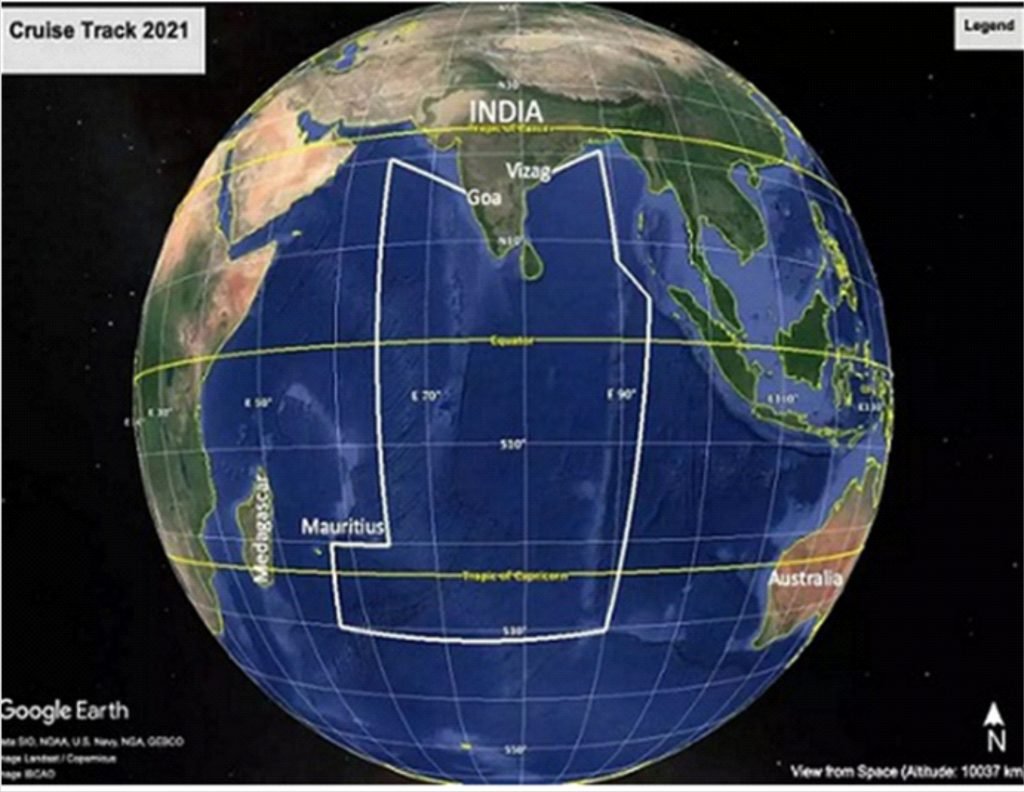Current Affairs (12th March 2021)
International Lunar Research Station (ILRS)
Context:
- Russia and China have agreed to build an ILRS, which would be built on the lunar surface and/or on the lunar orbit.
- This will mark the start of a new era in space cooperation between the two countries and strengthens scientific research exchanges, and promote humanity’s exploration and use of outer space for peaceful purposes.
ILRS:
- Comprehensive scientific experiment base with the capability of long-term autonomous operation
- The station would carry out scientific research activities like the lunar exploration and utilization, lunar-based observation, basic scientific experiment and technical verification.
REPORT BY WORLD BANK
CONTEXT:
- Connecting to Thrive : Challenges and Opportunities of Transport Integration in Eastern South Asia has recently been released by the World Bank (WB).
Findings:
- It investigates the extent to which the Bangladesh-Bhutan-India-Nepal Motor Vehicle Agreement (MVA) supports the cross-border operation of road transport services and identifies the gaps in the agreement that need to be addressed to improve its effectiveness.
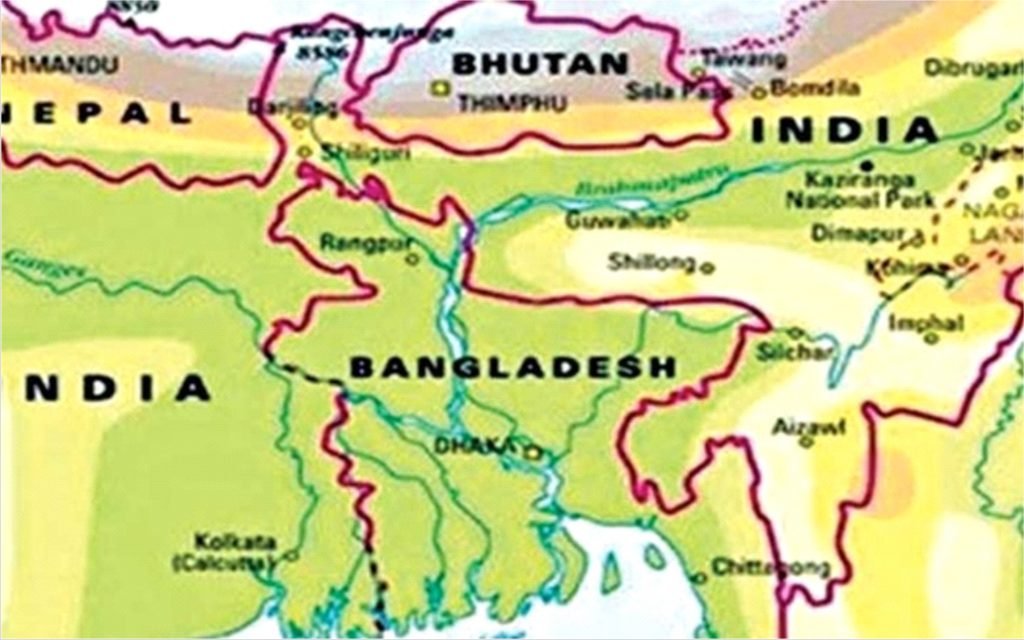
- Report suggests that Seamless transport connectivity between India and Bangladesh has the potential to increase national income by as much as 17 percent in Bangladesh and 8 percent in India.
- Bilateral trade accounts for only about 1% of India’s trade and 10% of Bangladesh’s trade.
- The most significant border post between India and Bangladesh at Petrapole–Benapole takes several days which shows weak transport integration.
- Particularly, India’s north-eastern states are isolated with rest of the country as it is connected through the 27-km-wide Siliguri corridor or “chicken’s neck” and Indian trucks are not allowed to transit through Bangladesh. This leads to long and costly routes.

Apprenticeship Outlook Report for 2021
Context:
- Apprenticeship Outlook Report for January-June 2021 has been recently released by National Employability Through Apprenticeship Program (NETAP).
Findings:
- Some 41% of the employers in India are keen on hiring apprentices.
- 58% of enterprises want to increase the quantum of their apprenticeship hiring this year.
- Overall the preference for women apprentices has increased by 10% from the previous half year, which was more visible in Mumbai, Bengaluru, Kolkata.
- The manufacturing, automobiles and ancillaries, and retail are the leading sectors.
- Among non-metro cities, Nagpurand Ahmedabad are the most promising cities for apprenticeship.
- Chennai has emerged as the most apprentice friendly city.
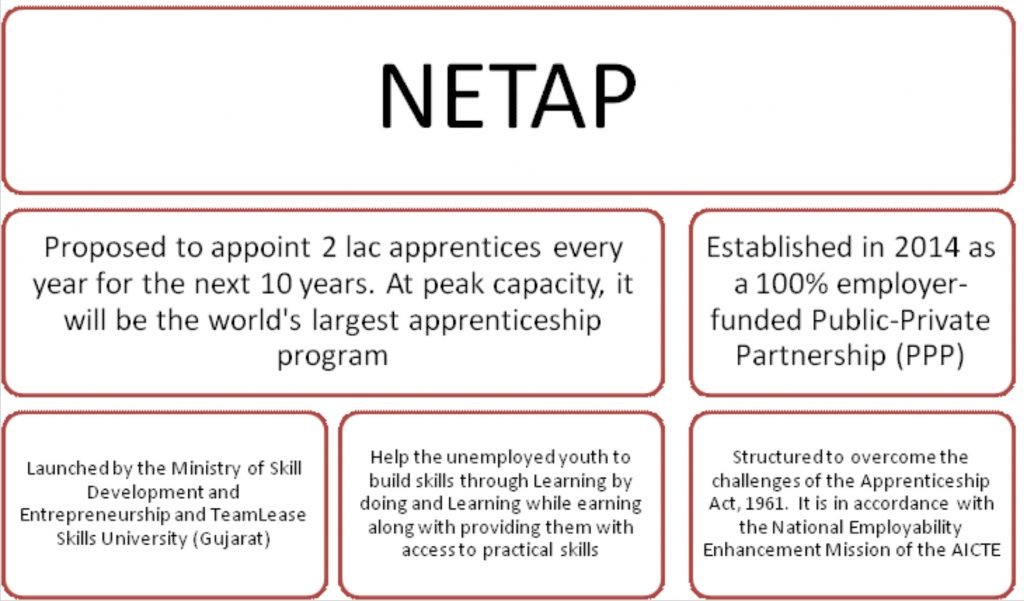
INS Karanj
Context:
- The Indian Navy inducted its third Scorpene-class conventional diesel electric submarine, INS Karanj, into service.
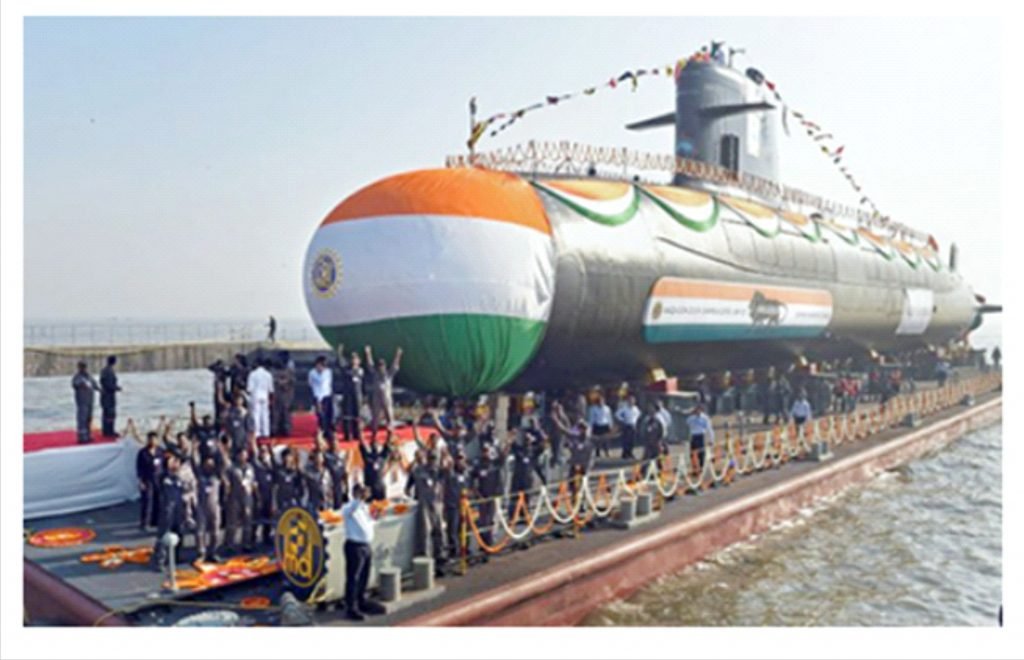
About:
- The first submarine of the class, INS Kalvari, was commissioned in December 2017 and the second, INS Khanderi, in September 2019.
- A fourth submarine, Vela, was launched into the water in May 2019 and the fifth, Vagir, in November 2020, and both are undergoing sea trials. The sixth is in an advanced stage of outfitting.
What are Scorpene-class submarines?
- These are one of the most advanced conventional submarines in the world. The submarine has superior stealth features, such as advanced acoustic silencing techniques, low radiated noise levels and ability to attack with precision-guided weapons on board.
- The Indian Navy intends to use the submarines for missions such as area surveillance, intelligence gathering, anti-submarine warfare, anti-surface warfare and minelaying operations. The submarines are armed with six torpedo-launching tubes, 18 heavy weapons, tube-launched MBDA SM-39 Exocet anti-ship missiles and precision-guided weapons.
- It can launch crippling attacks on surface and underwater enemy targets.
- Moreover, the attack submarines can travel at a maximum submerged speed of approximately 20 knots and have the ability to remain submerged for 21 days. It has a diving depth of more than 350 m.
- The Scorpene class of submarines were designed by French naval shipbuilding firm DCNS in partnership with Spanish shipbuilding firm Navantia.
Karanj
- The earlier version of the submarine, which belonged to the Foxtrot class, was first commissioned in 1969 at Riga in the erstwhile USSR.
- A proposal to form a submarine arm, also referred to as the silent arm, of the Indian Navy was first envisaged in 1959, but it was only in 1964 that the Soviet government agreed for transfer by purchase for four Foxtrot-class submarines, of which INS Karanj was a part.
- All the four constituted the 8th Submarine Squadron and played a key role during the 1970-71 Indo-Pak war. The INS Karanj went on to serve the nation for 34 years till 2003.
- Karanj has been equipped with the best sensors in the world and is fitted with an integrated platform management system to provide centralised propulsion and machinery control.
- The powerful diesel engines can quickly charge batteries for a stealthy mission profile. Also, its modular construction enables upgradation to air independent propulsion in future.
Project 75I
- Under this project of the Indian Navy, six latest-generation attack submarines are being built. They are expected to be completed by 2022. The project is taking shape at Mazagon Dock in Mumbai.
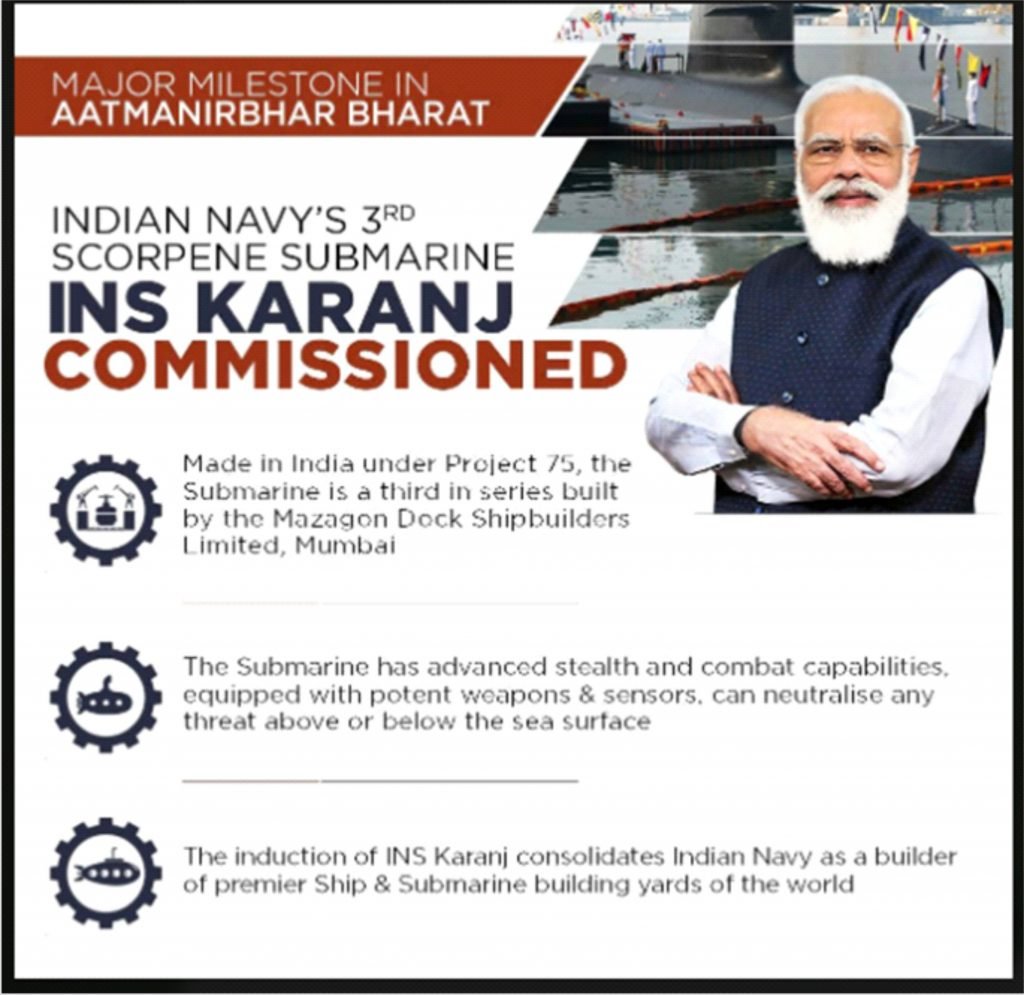
BamiyanBuddhas
Context:
- In March 2001, the Taliban began blowing up two monumental Buddha statues in Afghanistan’s Bamiyan Valley. The ancient BamiyanBuddhas were lost to the world forever. The destruction of the BamiyanBuddhas was part of this extremist culture.
- Now, two decades later, on the anniversary of the annihilation, the BamiyanBuddhas have been brought back to life in the form of 3D projections in an event called “A Night With Buddha”.
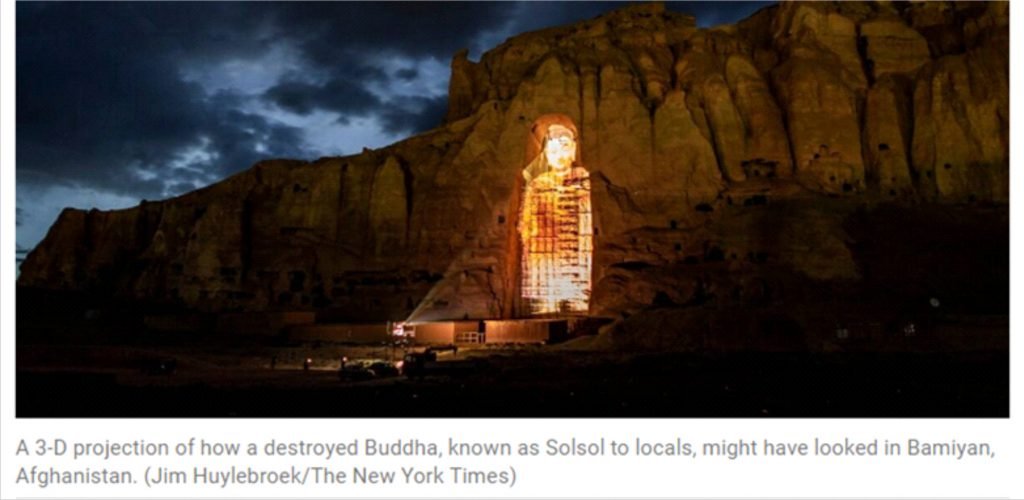
Legacy
- In their Roman draperies and with two different mudras, the BamiyanBuddhas were great examples of a confluence of Gupta, Sassanian and Hellenistic artistic styles.
- They are said to date back to the 5th century AD and were once the tallest standing Buddhas in the world.
- Salsal and Shamama, as they were called by the locals, rose to heights of 55 and 38 metres respectively, and were said to be male and female.
- Salsal means “light shines through the universe”; Shamama is “Queen Mother”. The statues were set in niches on either ends of a cliff side and hewn directly from the sandstone cliffs.
SIGNIFICANCE:
- Bamiyan is situated in the high mountains of the Hindu Kush in the central highlands of Afghanistan. The valley, which is set along the line of the Bamiyan River, was once integral to the early days of the Silk Roads, providing passage for not just merchants, but also culture, religion and language.
- When the Buddhist Kushan Empire spread, acting as a crucible of sorts, Bamiyan became a major trade, cultural and religious centre.
- As China, India and Rome sought passage through Bamiyan, the Kushans were able to develop a syncretic culture.
- In the rapid spread of Buddhism between the 1st to 5th centuries AD, Bamiyan’s landscape reflected the faith, especially its monastic qualities.
- The two colossal Buddhas were only a part of several other structures, such as stupas, smaller seated and standing Buddhas, and wall paintings in caves, spread in and around surrounding valleys.
Destruction
- The Taliban’s destruction of the BamiyanBuddhas met with global criticism, many of whom saw it as a cultural crime not just against Afghanistan but also against the idea of a global syncretism. Unfortunately, the event paved the way for similar attacks on cultural heritage
- Following the fall of the BamiyanBuddhas, UNESCO included the remains in its list of world heritage sites in 2003, with subsequent efforts made to restore and reconstruct the Buddhas in their niches with the pieces available.
- One of the prime concerns raised is about the need to rebuild Buddhist statues in an Islamic country, which no longer has the same sense of syncretism as during the Kushan Empire.
Mapping genomes
Context:
- A team of scientists and researchers from the National Institute of Oceanography (NIO) in Panaji and another 30 crew members onboard its research vessel SindhuSadhana will spend the next three months traversing the course of over 10,000 nautical miles in the Indian Ocean on a research project.
About:
- The first-of-its-kind research project in the country is aimed at understanding the biochemistry and the response of the ocean to climate change, nutrient stress and increasing pollution.
- Conceptualised over the last two to three years, the research project has been undertaken at a cost of Rs 25 crore and will take three years to complete.
- The research project that will be flagged off at Visakhapatnam course the Indian Ocean from India’s east coast, all the way to Australia, then onward towards Port Louis in Mauritius and up to the border of Pakistan, off India’s west coast, gathering samples for genome mapping of microorganisms in the Indian Ocean. The researchers will collect samples from various stretches of the ocean at an average depth of about 5 km.
- Just like gene mapping is carried out on blood samples collected from humans, the scientists will map these in the bacteria, microbes found in the ocean.
- The mapping of the Deoxyribonucleic acid (DNA) and Ribonucleic acid (RNA) will show the nutrients present in them, and also those lacking in different parts of the ocean.
Significance:
- The research will enable scientists to identify the factors controlling the changes in RNA, DNA in the oceans, and various stressors impacting them.
- The ocean has several micronutrients like nitrates, sulphates and silicates, minerals like iron ore and zinc, and trace metals like cadmium or copper.
- The genome mapping will show the presence of which these microbes have adapted to, in addition to their reaction to atmospheric carbon dioxide.
- This will help in identifying which part of the ocean has a greater concentration of which mineral or element.
